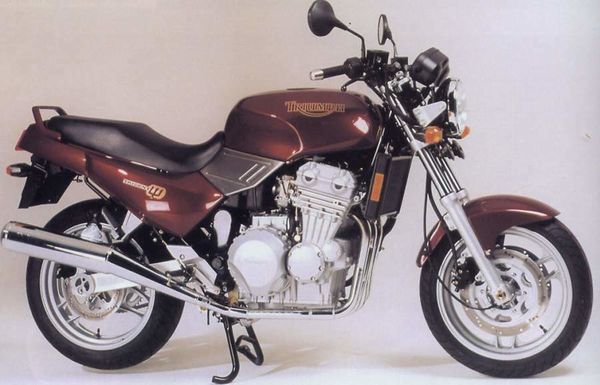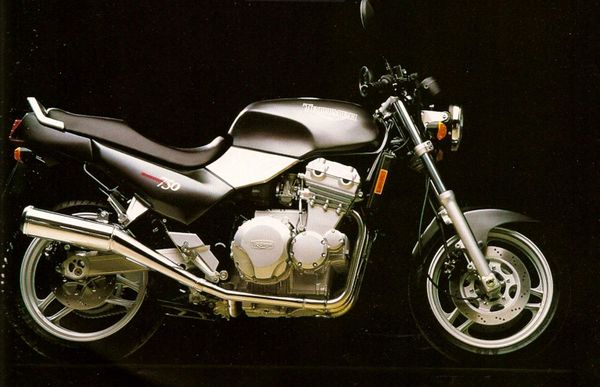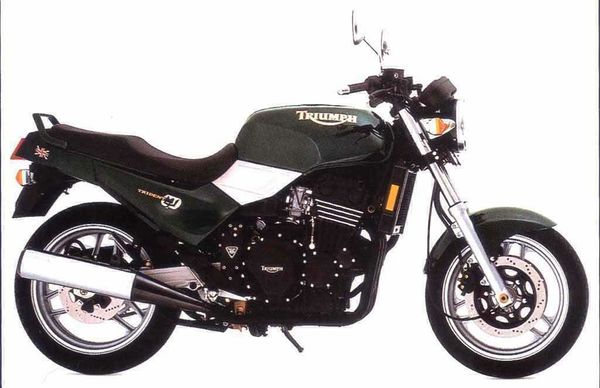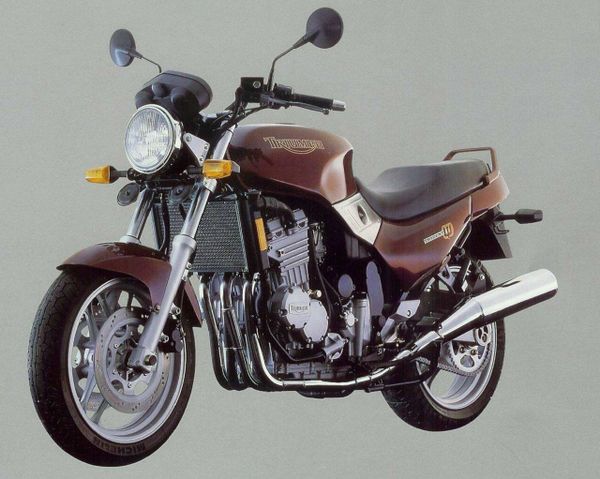Difference between revisions of "Triumph Trident 750"
(adding air filter) |
(has images) |
||
| Line 96: | Line 96: | ||
[[Category:1980s motorcycles]] | [[Category:1980s motorcycles]] | ||
[[Category:1990s motorcycles]] | [[Category:1990s motorcycles]] | ||
Revision as of 03:02, 19 November 2019
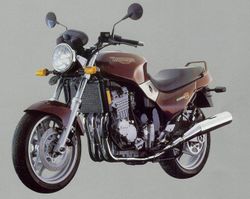 |
|
| 'Triumph Trident 750' | |
| Manufacturer | [[Triumph]] |
|---|---|
| Also called | Trident 750 (reduced effect #2), Trident 750 (reduced effect) |
| Production | 1968 - 1998 |
| Class | [[:Category:Naked motorcycles|Naked]] [[Category:Naked motorcycles]] |
| Engine | in-line three, four-stroke |
| Bore / Stroke | 76.2mm x 76.2mm |
| Compression ratio | 11.0:1 |
| Top Speed | 124 mph (200 km/h) |
| Horsepower | 84.22 HP (62.8 KW) @ 10000RPM |
| Torque | 64.17 ft/lbs (87.0 Nm) @ 8700RPM |
| Fuel System | 3x36mm BST CV, carburetors |
| Air Filter | K&N TB-9091 `92-97[1] |
| Transmission | Gear box: 6-speed Final Drive: chain |
| Suspension | Front: 43mm telescopic forks, non adjustable Rear: gas monoshock, adjustable preload |
| Brakes | Front: dual disc Rear: single disc |
| Front Tire | 120/70-17 |
| Rear Tire | 160/60-18 |
| Wheelbase | 59.41 inches (1509 mm) |
| Seat Height | 29.92 inches (760 mm) |
| Weight | 467.38 pounds (212.0 Kg) (dry), 212.0 kg (wet) |
| Oil Filter | K&N KN-192[1] |
| Fuel Capacity | 6.6 Gallon (25.00 Liters) |
| Manuals | Service Manual |
The Triumph Trident 750 was a in-line three, four-stroke Naked motorcycle produced by Triumph between 1968 and 1998. It could reach a top speed of 124 mph (200 km/h). Max torque was 64.17 ft/lbs (87.0 Nm) @ 8700 RPM. Claimed horsepower was 84.22 HP (62.8 KW) @ 10000 RPM.
Engine
The engine was a liquid cooled in-line three, four-stroke. A 76.2mm bore x 76.2mm stroke result in a displacement of just 749.0 cubic centimeters. Fuel was supplied via a double overhead cams/twin cam (dohc).
Drive
The bike has a 6-speed transmission. Power was moderated via the wet multiplate.
Chassis
It came with a 120/70-17 front tire and a 160/60-18 rear tire. Stopping was achieved via dual disc in the front and a single disc in the rear. The front suspension was a 43mm telescopic forks, non adjustable while the rear was equipped with a gas monoshock, adjustable preload. The Trident 750 was fitted with a 6.6 Gallon (25.00 Liters) fuel tank. The bike weighed just 467.38 pounds (212.0 Kg). The wheelbase was 59.41 inches (1509 mm) long.
1992 Triumph Trident 750
The 1992 MY Triumph Trident 750 is a smaller-displacement alternative to its Trident 900 sibling. It is a little lighter, thus the throttle feels more responsive, and it can corner better. It sports a four-stroke, liquid-cooled, 749cc in-line three-cylinder engine mated to a sturdy six-speed manual transmission.
The suspension, a 43mm telescopic fork and a gas mono-shock with adjustable preload, copes well with the bulky size of the machine and, at high enough speeds, will even allow the rider to lean into corners confident that he can flick the bike upright on the other side.
1993 Triumph Trident 750
The 1993 MY Triumph Trident 750 sports the smallest-displacement engine Triumph have to offer, but that doesn't make it less fun. Smaller engine means a lighter bike, and a lighter bike means more joy for the rider when he's tackling winding country roads in a weekend outing.
The 749cc, four-stroke engine produces 97 horsepower and 66 Nm of torque, which may not seem so impressive, but it is still enough to give the average rider a thrill when reaching the top end of the rev range, without causing a mini heart-attack.
1994 Triumph Trident 750
The 1994 Triumph Trident 750 is a suitable choice for novice riders, but not only, who want to own a machine from the reborn Hinckley firm. It has the smallest displacement engine in all the models the Brits have to offer, but that does not mean it is dull. On the contrary, it is one of the lightest and most fun machines they have released as of yet, and more than capable to make one giggle like a school-girl when it reaches its top revs.
Light weight means that it is easier to handle, and when you add a 43mm telescopic fork and a gas monoshock rear suspension to the equation, it is more than likely that one won't leave the roundabout at least after a few full turns.
References
- ↑ 1.0 1.1 2019 K&L Supply Co Catalog. K&L Supply Co. 2019.
